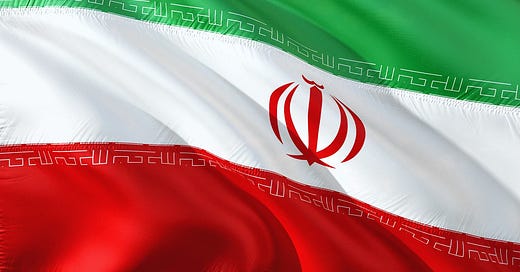Understanding the History Behind the Iran-Israel Conflict (Part One)
For Journalists and Communication Specialists
[I wrote this series prior to the United States bombing Iran, so you will not find it mentioned in this newsletter. I’ll refer to it in Part Two.]
Iran and Israel lead almost every newscast these days, so it might be helpful for journalists and communication specialists to know more about the history in that part of the world.
Why am I writing about this now? To explain the link between the past and the present. My hope is that knowing the ancient and modern histories of these conflicts in the Middle East will help journalists cover the complexities of this important story.
The ancient Israelites and Persians have a common ancestry. They both come from Noah’s son Shem.
“The sons of Shem were Elam, Asshur, Arphaxad, Lud, and Aram.” Genesis 10:22
Elam’s family, the Elamites, eventually became known as Persia, which is today known as Iran. Some of Arphaxad’s family became what is known today as Israel.
Elamites
Elam would have been a cousin of Nimrod, another grandson of Noah. Nimrod is listed in the Bible as building the first ‘kingdom’ in the world following the Flood. Nimrod’s kingdom developed after God ‘confused’ the languages of the families of Noah’s children (Genesis 11).
Nimrod’s kingdom included most of ancient Mesopotamia, but did not include the kingdom of Elam. By the time we get to Abraham, Elam was a powerful kingdom.
Other kings (located in an area that includes the location of ancient Israel) served the king of Elam (Chedorlaomer) for more than a decade until they decided to rebel. That led to a major war among nations (Genesis 14).
Abraham played a major role in defeating the Elamite army —
“Now when Abram heard that his brother was taken captive, he armed his three hundred and eighteen trained servants who were born in his own house, and went in pursuit as far as Dan. He divided his forces against them by night, and he and his servants attacked them and pursued them as far as Hobah, which is north of Damascus. So he brought back all the goods, and also brought back his brother Lot and his goods, as well as the women and the people. And the king of Sodom went out to meet him at the Valley of Shaveh (that is, the King’s Valley), after his return from the defeat of Chedorlaomer and the kings who were with him.” Genesis 14:14-17
Elamite and Hebrew History
Many historians view the Elamites as rivals of the kingdoms to its west (the ones built by Nimrod and his successors). Historians often break Elamite history into four parts:
Proto-Elamite Period (c. 3200 – 2700 BC)
Old Elamite Period (c. 2700 – 1500 BC)
Middle Elamite Period (c. 1500 – 1100 BC)
Neo-Elamite Period (c. 1100 – 540 BC)
Abraham’s battle with the Elamite King Chedorlaomer and the kings who were with him was probably during the middle part of the Old Elamite Period.
Archeologists and historians have discovered that the Elamite people were intelligent, strong, and quite political throughout each period. The Elamites eventually became known as ‘Persians.’ The first Persian ‘Empire’ was known as the Achaemenid Empire. The ‘founder’ of that empire played a pivotal role in freeing the people of Israel from Babylonian captivity —
“Cyrus the Great (born 590–580 BCE, Media, or Persia [now in Iran]—died c. 529, Asia) was a conqueror who founded the Achaemenian empire, centered on Persia and comprising the Near East from the Aegean Sea eastward to the Indus River. He is also remembered in the Cyrus legend—first recorded by Xenophon, Greek soldier and author, in his Cyropaedia—as a tolerant and ideal monarch who was called the father of his people by the ancient Persians. In the Bible, he is the liberator of the Jews who were captive in Babylonia.” Britannica
Cyrus allowed Jews who wanted to return to Judah to do so. However, Judah’s neighbors disapproved and complained to Persia’s king. Many years later King Darius of Persia made a search of the archives stored in Babylon and discovered the decree of King Cyrus. Upon that discovery, King Darius ordered that the Jews could move forward with rebuilding the Temple in Jerusalem.
Defeat
The early Persian Empire was a powerful force that ruled from India to Egypt to Greece for two centuries. However, Alexander the Great defeated the empire in a series of battles from 334 BC to 331 BC. The Persian Empire came under Alexander’s rule. After Alexander died in 323 BC, one of his generals (Seleucus I) was able to establish rule over Persia — along with Mesopotamia, Syria, and Israel.
However, the Seleucid Empire began losing control of some of its territory during the 3rd century BC. Rome defeated the Seleucids in the 2nd century BC, but that wasn’t the end of Persian resistance. They fought against Rome for centuries. Historians call the conflicts the ‘Roman-Persian Wars.’ They continued for centuries — finally coming to an end about 628 AD. Those centuries of fighting weakened both empires.
Arrival of the Muslims
Muhammad began what are known as the ‘Muslim conquests’ in 622 AD. The Rashidun Caliphate defeated the Sassanian Empire — beginning the eventual decline of Persia’s longtime religion of Zoroastrianism. Persia eventually became Muslim, but it never became part of the massive Ottoman Empire. Persia was a rival empire to the Ottomans, often fighting over land in Iraq, Asia Minor, and other areas. It also led Persians to leave Sunni Islam and become leaders of Shia Islam.
“Sunnis dominated the first nine centuries of Islamic rule (excluding the Shia Fatimid dynasty) until the Safavid dynasty was established in Persia in 1501. The Safavids made Shia Islam the state religion, and over the following two centuries they fought with the Ottomans, the seat of the Sunni caliphate. As these empires faded, their battles roughly settled the political borders of modern Iran and Turkey by the seventeenth century, and their legacies resulted in the current demographic distribution of Islam’s sects. Shias comprise a majority in Iran, Iraq, Azerbaijan, and Bahrain, and a plurality in Lebanon, while Sunnis make up the majority of more than forty countries from Morocco to Indonesia.” Council on Foreign Relations
You’ll find more information about ‘modern tensions’ between the two sects of Islam here. This will also help journalists understand the tensions between Iran and Saudi Arabia.
“Iran’s Islamic Revolution in 1979 gave Shia cleric Ayatollah Ruhollah Khomeini the opportunity to implement his vision for an Islamic government ruled by the “guardianship of the jurist” (velayat-e faqih), a controversial concept among Shia scholars that is opposed by Sunnis, who have historically differentiated between political leadership and religious scholarship. Shia ayatollahs have always been the guardians of the faith. Khomeini argued that clerics had to rule to properly perform their function: implementing Islam as God intended, through the mandate of the Shia Imams.” Council on Foreign Relations
Conclusion
I will continue this series in next week’s Substack newsletter by looking at Israel’s history with Iran.
I strongly believe that journalists and communication specialists should know the history of what they cover and about what they report — whether it be ancient or recent. My sense of much of the coverage I’ve watched and read about what’s happening in the Middle East today is that many journalists know little about the long military and political history of the area. The lack of knowledge and understanding of the history of Iran and Israel is a detriment to viewers, readers, and listeners — especially during a time of military tensions and actions. The reason is that much of the coverage lacks historical context, which is vital to fully understanding what is happening now.
Wars between countries in the Middle East have been going on for thousands of years. What we’re seeing now may be new to us, but it’s not to those countries. I hope this series will give you information that helps your reporting.
Comments and Questions Welcome
I hope these thoughts are helpful to you. Please share your comments and questions and I will respond as quickly as I can. If you like what we’re doing in this newsletter, please let your friends know about it so they can subscribe.
Newsletter Purpose
The purpose of this newsletter is to help people who work in the fields of journalism, media, and communications find ways to do their jobs that are personally fulfilling and helpful to others. I also want to help news consumers know how to find news sources they can trust.
[The Real Journalism Newsletter is published every other Tuesday morning — unless there’s ‘breaking news!]






Thank you Mark for sharing your knowledge concerning these two ancient adversaries. It helps to know where all this present day conflict started and continues unfolding today.